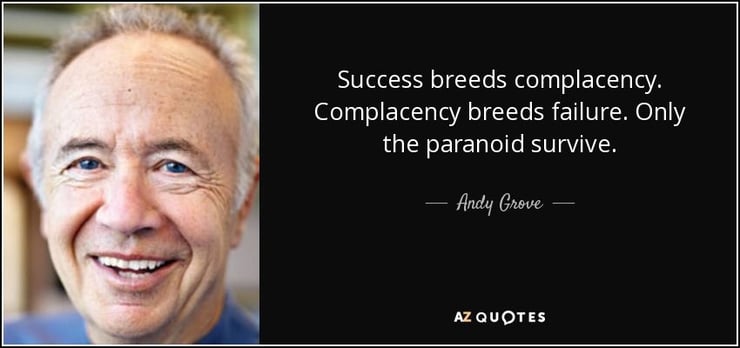8 min read
Rethink OKRs: Improve Cultural Engagement with Your Own System
Here we'll explore the backstory of OKRs, what's changing in the markets, and why it's important to stay ahead of the...

There’s an overwhelming amount of information about OKRs available online. So, we compiled and analyzed every definition, term, acronym, and phrase we could find related to OKRs and consolidated it into a single document.
We've broken these out into five categories for more context - Acronyms to Know, Culture Terms, Execution Terms, Key Result Terms, OKR Terms, Logic Model Terms, and Personas. Enjoy!

OKR Terms
Although most of the terms in this post are OKR-related, these are the most generic ones that you will hear directly correlated to OKRs.
Bottom-Up – When teams from the bottom-up create and align an OKR to a higher level. This is representative of an OKR program going extremely well because it means everyone in the organization - from leadership to ownership - is contributing.
Cascading - Ensuring all OKRs are connected, top-down and bottoms-up, ensuring tight alignment between groups. When KR’s are so big they need to be broken down, consider “Cascading KR’s” which means the KR turns into its own Objective with additional KR’s underneath.
Confidence level - Rating how confident you are in achieving the Objective or Key Result.
Contributor - Being involved with an OKR but not owning the Objective or the Key Results.
Cycle - Represents the window of time in which an OKR is executed against. We recommend quarterly cycles. Three months is a good balance between thinking strategically and executing effectively.
Key Results - Quantitative and verifiable measurement of progress. Key Results mark progress towards the achievement of an Objective. If you successfully achieve all your Key Results, you’ve met your Objective.
Objectives - Inspirational, directional, and qualitative description of what is to be achieved and why you want to achieve it.
OKR Program - Encompasses all the OKR components within the business (people, assets, courses, operational cadence, technology, etc.) working together in unison.
Pivoting - Retiring an OKR and replacing it with improved use of time, effort, and resources. Pivoting is different from just “deleting” in that you want to have this decision reference-able in the future.
Private OKR - Related to OKRs which contain sensitive or confidential information.
Reflection - The process of examining what happened during the OKR lifecycle, with the intent of improving things in the future based on those learnings.
OKR Leader - This is the person who is responsible for the entire OKR program. Often appointed by the CEO, and commonly referred to as the OKR Champion, this person's focus is to lead organizational-wide change.
Top-down - Upper Management or administration creates a mission statement or goal that cascades down to all employees.
Key Result Terms
We've broken out Key Results into three categories to put more context into the type of KR each is.
Committed KR - 100% achievement is expected. This can be across an OKR or just a KR.
Moonshot KR - Something so big and amazing that it almost seems virtually impossible, but part of you does believe it’s possible.
Stretch KR - 70% achievement is great.
Logic Model Terms
The Logic Model is a systematic way to represent the resources you have at your disposal, the activities you plan for, and the impact you hope to make. This model illustrates the connection between your planned work and your intended results.
Inputs - The actual work that gets done, generally leads to output (i.e., technology, materials, meetings).
Outcomes – A business outcome is a concise, defined, and observable result or change in business performance, supported by a specific measure. *Measurable outcomes make great Key Results*
Output - Aggregation of initiatives, projects, deliverables, activities, or tasks (i.e., call 50 customers, email 10,000 users, schedule 10 meetings, etc.).
Acronyms To Know
Acronyms aren't going anywhere anytime soon in the business world, but we did want to call out a few which frequently get associated with OKRs.
OKR - Strategic goal-setting methodology which combines “Objectives” – short, memorable descriptions of what is to be achieved – and “Key Results” – measurable progress of success – in a shared and visible forum to promote focus, alignment, and performance.
BAU - "Business As Usual" or your “day to day” job which really shouldn’t be reflected in an OKR. Checking emails, going to meetings, clocking in at a certain time, and the list goes on. If it’s expected, it’s BAU.
CFR - Stands for "Conversation, Feedback, and Recognition", and is more of a 1:1 management function within OKRs.
CPM - Continuous Performance Management. This is different than annual reviews in that performance and feedback is given throughout the year via check-ins. When CPM is used in conjunction with OKRs it can be a place for planning, analyzing, and providing feedback on performance from a manager.
KPI - "Key Performance Indicator." These are metrics that measure activities already in place. Business as usual is best measured through KPIs. Be selective when deciding which KPIs should become a Key Result. Every Key Result should be a KPI, but not every KPI needs to be a Key Result. KPIs should only become Key Results if they start to become a problem. For instance, bounce rate is a KPI. If the average bounce rate is 25% and then it suddenly climbs to 65%, you need to create an OKR to fix it.
Culture Terms
Culture eats strategy for breakfast, as they say, so we felt it was important to include some key terms related to OKRs and how they can improve culture.
Autonomy - The ability to work freely and without restriction, yet still within the guardrails of business value.
Empowerment - The ability to contribute in a way that does not feel like a "control and command" environment. Empowerment is about freedom, flexibility, and trust.
Task Force - A task force is a temporary team created to address a single piece of work, a problem, or a goal.
Transparency - Providing information to external stakeholders in an effort to promote trust and accountability. Transparency differs from visibility in that it is external in nature, whereas visibility is internal.
Value - Quality x efficiency x benefit to others.
Visibility - Providing information to employees to promote trust and accountability. Visibility differs from transparency in that it is internal in nature, whereas transparency is external.
Execution Terms
Execution often gets lost in translation while everyone runs around from meeting to meeting. We wanted to change that by separating execution from outcomes through the work of OKRs. Although you may define or label the items below differently, at the end of the day we're just talking about physical work getting done. It's that simple!
Action Item - Typically a new work task that comes out of a meeting or check-in.
Deliverable - Tangible assets (digital or physical) that are created (i.e., document, blog, article, webpage, design mockup, etc.).
Initiatives - Strategic in nature. Bigger efforts that fuel Key Results. If the Initiative is noteworthy enough to share with a member of the C-Suite, it's probably an initiative.
If there’s something you believe should be on here shoot us a note at marketing@krezzo.com and we’ll evaluate your recommendation, or just schedule time with us to discuss live. Thanks!
Sep 7, 2023by Stephen Newman
Here we'll explore the backstory of OKRs, what's changing in the markets, and why it's important to stay ahead of the...
Aug 20, 2023by Stephen Newman
Let's skip the part where the basics of OKRs are shared and debates over definitions are had. Let's get right to the...
Aug 13, 2023by Stephen Newman
The difference between OKRs & KPIs is an ongoing conversation with the common narrative being "KPIs are for running the...